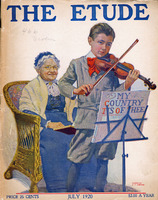M. A.—Your only course is to send your violin to an expert for examination, and appraisal. You will find the names of several dealers in old violins in the advertising columns of The Etude, who can do this work for you, for which they would, of course, charge a fee.
M. C.—As you know something of music already, and seem to possess a genuine love for it, it is possible that you might accomplish a great deal, starting even as late as 18. I could not hazard a guess as to what you could do, without a personal hearing. Take a term of lessons from some good violin teacher, and he will then be able to advise you.
M. C.—To keep your pegs in good working order, wet your finger, rub over a cake of soap, and twirl the peg around in your fingers, then rub chalk on the peg. You will find that it will turn easily in the peg hole, but the chalk will keep it from slipping. 2. If by a patent head you mean the keys with cog-wheels such as are used on the mandolin, it is an insufferable nuisance. It is heavy, and the cog-wheels wear and rattle, and nothing but trouble follows their use. If you have your pegs well fitted by a good violin maker, you will not have the slightest trouble in tuning.
A. C.—As a general rule of violin technic the fingers are held on the strings as much as possible, otherwise the violinist would do much unnecessary labor, and his intonation would suffer. However, there are exceptions to all rules, and in the case of single notes in slow tempo such as you speak of, requiring free finger and wrist action for the vibrato, there is no harm in raising all but the finger producing the tone.
N. V. G.—You might name your trio after the first violinist, or one of the other members, or after one of the great composers, as "Mozart Trio," "Haydn Trio," etc. You might get engagements in other cities by advertising in musical journals of general circulation, or by writing to churches, lodges, societies, and to personal friends in towns and cities near your home town. Engagements of this kind are often secured through friends, or through a personal visit to towns where you think engagements might be secured.
W.—To learn the vibrato, get Eberhardt's work on the Vibrato and its Artistic Uses. An excellent little work on violin playing is the Violin and How to Master It, by Honeyman, also Secrets of Violin Playing by the same author.
C. A.—The label in your violin means (if genuine) that the violin was made by Giofredo Cappa, in Italy in the year 1640. Cappa was the pupil and imitator of Amati. There are a good many factory fiddles about, with the Cappa label, so yours may not be genuine, You (sic) would have to have it examined by an expert to ascertain definitely.
L. L. P.—If you have studied the works you name thoroughly, you might take up the third book of Kayser's Op. 20 and Mazas' Special Studies. For pieces you might useDancla's Six Little Fantasias for violin and piano.



